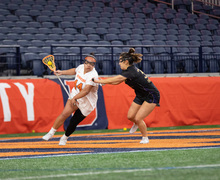Proposed I-81 community grid alternative could benefit Syracuse
Elizabeth Billman | Asst. Photo Editor
NYSDOT and the city of Syracuse are finally making plans to improve the damage I-81 has caused, a long overdue change.
The issues surrounding Interstate 81 in Syracuse are extremely complex: the roadway is vital to members of the community but it has also created countless problems for residents surrounding the highway. I-81 provides quick, efficient and safe access to businesses, schools, homes and other neighboring cities. Yet it also divides the city and splits low-income communities from high-income communities. I-81 has a dark history of furthering pollution, poverty and gentrification.
The elevated portion of the highway stretching over Almond Street, known as the viaduct, has been in use for over 50 years. This stretch in particular has experienced significant damage and has been the scene of a number of accidents.
In 2008, the New York State Department of Transportation initiated a review of the highway, titled the I-81 Corridor Study. It studied the 12-mile corridor in Syracuse until 2013 to inform NYSDOT and the Federal Highway Administration as they look into the social aspect of the project. The studies found that the densest populations of people below the poverty line existed in and around Syracuse University and that families are choosing to move away from the city of Syracuse.
While the future of I-81 has been debated by the local and state governments for a while, we are finally seeing some changes, such as the start of preliminary work as well as public hearings on the matter, NYSDOT announced.
I-81 serves many residents of Syracuse, including students, employers and employees in the surrounding area, as well as producers and consumers all over the world.
NYSDOT with the city of Syracuse has proposed a number of potential fixes for the viaduct. The “community grid” solution proposed by NYSDOT would get rid of the viaduct altogether in an attempt to slow and disperse traffic, which would be great for Syracuse businesses. The proposed community grid also provides new and improved pedestrian and bicycle facilities, which would benefit Syracuse locals in the area.
While this plan sounds great, there have been alternatives proposed, most of which would not provide as many benefits for Syracuse. One is the “No Build Alternative” solution, which would require no new construction, just maintenance to the existing viaduct. It is one of the cheaper solutions, however, it would not solve the deeper issues rooted in I-81’s displacement of Black and brown communities.
Another possible solution is the “Viaduct Alternative” which would entail a $2.2 billion project that would be expected to take six years and would ultimately replace the existing viaduct with a new and improved viaduct, including a new full I-81/I-690 interchange with connections in all directions.
However, sometimes we have to take one step back to take two steps forward. In the long run, changes to the corridor, specifically the community grid alternative, will be great for Syracuse as change in the communities around I-81 is necessary and reconstructing this stretch of highway is the best shot at achieving that change.
While the future of the I-81 stretch in Syracuse is largely unknown, it is known that the city needs a change. The community grid solution is the most balanced plan considering the problems at hand and the cost of all of the potential projects. This plan will help bridge the disconnects in the city, and it is the first step to creating a more engaged and interconnected community.
Many local businesses thrive off of the addition of SU students to the area. Additionally, students gain a lot from being able to utilize the city and connect with the community. Creating more access between the university and the city will only strengthen the bond between SU and the entire Syracuse community.
Many of the plans also include positive additions to the city itself to complement the reconstruction of the highway. These include the addition of pedestrian, bicycle and recreational facilities, as well as cleaner and safer road conditions, the dispersion of traffic, the acquisition of buildings and businesses, a more efficient route of transportation and, eventually, a more open and welcoming community.
Aiden Walsh is a freshman finance major. His column appears biweekly. He can be reached at awalsh05@syr.edu.
Published on November 29, 2021 at 12:00 am






